 | 330 GT Registry |  |
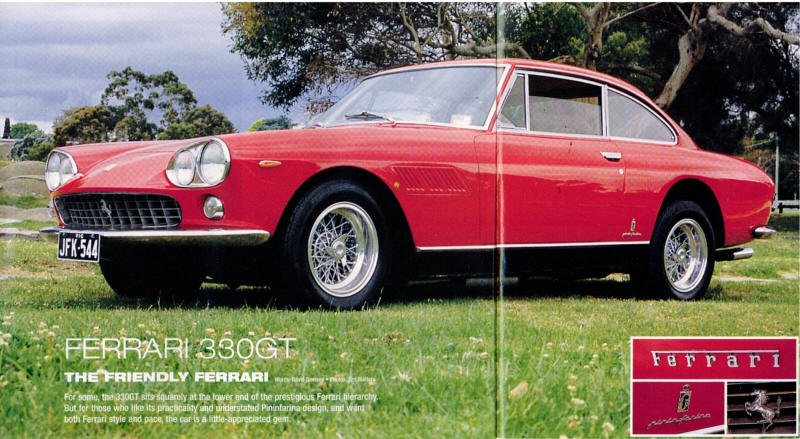
FERRARI 330GT
THE FRIENDLY FERRARI Words: David Dowsey Photos: Ern Matters
For some, the 330GT sits squarely at the lower end of the prestigious Ferrari hierarchy.
But for those who like its practicality and understated Pininfarina design, and want
both Ferrari style and pace, the car is a little-appreciated gem.
It has been suggested that Ferraris Rampante Cavalino (Prancing Horse) badge s, along with the Coca-Cola emblem, the most widely recognised symbol in the world. What is perhaps even more remarkable is that Ferrari has achieved this recognition without advertising. Their very public image is largely projected by racing and, in Formula One, Ferrari are currently at the top of the tree right now. t has worked very well, of course, because no other make of car comes close to engendering the fanatical following that Ferrari enjoys.
LINEAGE
The 1960s were a very fertile period for the Maranello Company. By the end of the decade production of road cars had doubled and their competition programme continued to gather pace. Many of the iconic Ferrari cars were produced during this period as well, including the 250 GT SWB, 250 GTO, 250 LM, 275 GTB, Dino 206 GT and the 365 GTB/4 Daytona.
The 330 GT had big shoes to fill when if was released on 11th January 1964, replacing the 250 GTE. The 330 GT enjoyed a production life of around four years, and in that time over 1000 cars were produced. The 330 GT was replaced by the 365 GT 2+2 in 1967.
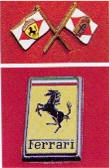 PININFARINA CONNECTION
PININFARINA CONNECTION
The great design and coachbuilding house (or Carrozzeria) of Pininfarina is irrevocably linked to Ferrari. Over the years they have been able to bring out the best in each other. Most of Pininfarina's best designs are on Ferrari cars and Pininfarina designed many of Ferraris most attractive models. The two companies are like peas in a pod.
The Pininfarina-designed 330 GT, however, draws mixed emotions from followers of the marque. Some find any Ferrari with more than two seats compromises the body design and performance, while others baulk at the twin Chinese headlights. This, in part, explains the relatively low price, by Ferrari standards.
In terms of bragging power, Ferrari sits at the top of the tree in classic car circles. But amongst Ferrari tans there is yet another pecking order and the 330 GT is positioned on the more humble half of that ladder. But, for most, this is still haughty motoring indeed.
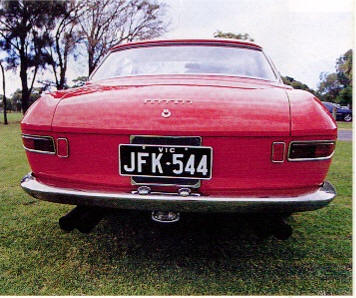 STYLING
STYLING
From any angle, the 330 GT is a handsome, well-proportioned motorcar. At the front, the car features an egg box grille with a Prancing Horse badge sitting proudly In the centre of it. The indicator lights are beautifully recessed into the bodywork either side of the grille and there is a slim wraparound chrome bumper. A yellow Ferrari bonnet badge and the Infamous quad-headlights round oft the frontal aspect.
The car is characterised by an almost complete lack of ornamentation, There is nothing particularly decorative or ostentatious about the design and the car is better for this fact, The sides of the car incorporate black sill plates,] beautifully crafted chrome door handles and slanted gills just aft of the front wheel arches to aid engine cooling. A nice touch is the inclusion of the Pininfarina flag on both sides of the car, located just in front of the rear wheels.
A wrap-around bumper is also employed at the rear, which is dominated by large light clusters and no less than four exhaust pipes. An unusual design feature is that the rear window is slightly recessed, creating a step down from the roof.
The three-eared, knock-oft Borrani wire wheels complete a very neat package. The 330 GT, by the way, was the last Ferrari car to feature wire wheels as standard. Later cars were usually supplied with alloy wheels but could be equipped with wires at the request of the customer. All In all, it is a very elegant and, more importantly, usable Ferrari.
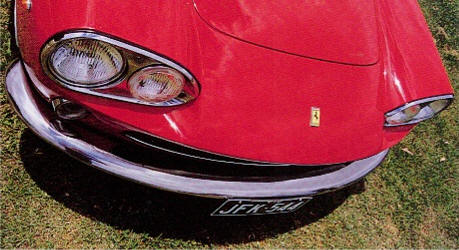

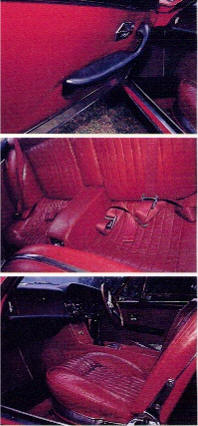
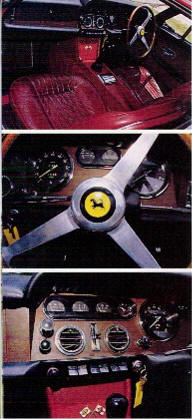 INTERIOR
INTERIOR
Personally, while many ‘70’s and ‘80’s Ferrari interiors do not entice me, I find the 330 GT's 1960’s-style cabin both understated and elegant. Dominated by a wooden Nardi steering wheel featuring the Rampante Cavalino horn boss, the cabin is an intelligent mix of functionality and comfort. I found it reasonably roomy in both the head and legroom departments, but even though there are nicely trimmed rear seats, they are really only suitable for children or, at a pinch, adults for a short trip.
The leather seats are very comfortable and it was easy for me to find a comfortable driving position! Directly behind the steering wheel Is a comprehensive row of Veglia Instruments. A large rev counter and speedometer dominate the drivers view, but also located on the wooden dashboard are dials for oil temperature, oil pressure, petrol, amp meter, water temperature and a clock! The handbrake Is located by the drivers left leg along the transmission tunnel! The polished aluminium accelerator pedal is very narrow and the actual foot well is short on space, as the transmission tunnel is unusually wide.
There is a usable glove box located In front of the passengers seat and located on the transmission tunnel is an ashtray featuring the flags of both Ferrari and Pininfarina. A cigarette lighter is also included.
There are electric windows, but just in case the Italian electrics fail you, there is a manual winding handle located in the glove box, which is a nice touch. There is a heater as well to keep you warm during winter, but I suspect that it would get very little use. The front and rear quarter windows can also be opened to allow for cooling air to enter the cabin. The car is very comfortable but once on the move, you’ll have to raise your voice to be heard above the din of that glorious V12. The car is trimmed in lovely maroon coloured leather and this Is highlighted with small pieces of black vinyl trim on the dashboard top and doors. The comfortably worn-in seats have a lovely patina, the floor is covered in maroon carpet and the roof Is lined In a fluted cream vinyl.
Vision, both rear and aft, Is excellent; a comment one couldn't make about many Ferraris, The boot is also of a very generous size and could swallow up several suitcases. All up it completes a package that renders this car a very usable, high performance classic for anyone who has children or wants to go on driving holidays with a reasonable amount of luggage.
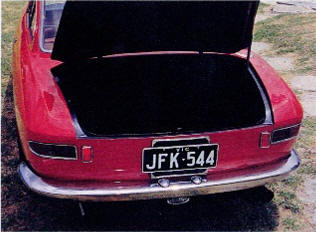

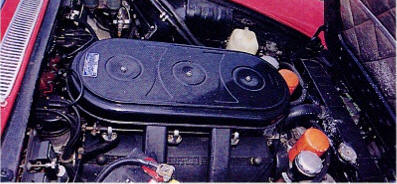 SPECIFICATION
SPECIFICATION
At the heart of all Ferraris is, of course, the engine. The Ferrari V12 is a light alloy, overhead cam V12 with two valves per cylinder. The engine displaces 3967cc and it has a compression ratio of 8,8:1. The usual carburettor set-up Is, as on this car, three Weber 40 DCZ/6 down draught carburettors. But owners could opt for a different set-up if desired, In this form, the car pumps out a claimed 300 bhp, a very good figure for its day. pushed hard it could hit 245 km/h, which was even better, especially if you take into account the cars 2+2 status.
The car is built up on top of an elliptical section steel chassis and features independent front suspension and a live rear axle. The brakes are Dunlop discs on all four wheels. The wheels are 15-inch Borrani wires filled with Pirelli P5 205/70 VR15 tyres, The steering is unassisted.
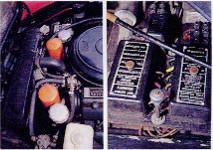
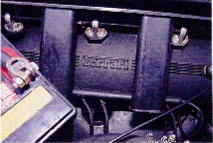
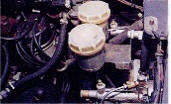
330 GT EXPLAINED
The 330 GT’s name is derived from 330cc per cylinder. Hence, the V12 motor boasts 3,967cc altogether, or four litres rounded up. The G1 stands for Gran Tourismo (Grand Touring), a specification first used by Maserati, but one that can be found on many of Ferraris great road cars.
The 330 GT ran from 1964 to 1967 and, depending on whom you talk to, it can be divided into two or three series. basically, the Series One can be identified by its quad-headlights, a first for Ferrari, The Series Two! which came on board in mid 1965, had single headlights and some mechanical and cosmetic changes. But as is often the case, a third subgroup emerged when about 125 cars were built with the headlights of the Series One and the mechanical specification of the Series Two.
As time went by, changes to the Series One included the incorporation of a five- speed gearbox in place of the four-speed plus Laycock overdrive. The front and rear tracks were widened from 1,397mm to 1,405mm and 1,389mm to 1,397mm respectively. A wooden dashboard replaced the painted one, the quad headlights morphed into single units and the round front indicators became rectangular. Alloy wheels replaced the wire wheels and the accelerator, brake and clutch pedals were changed from floor mounted to overhead mounted to combat rust problems encountered in earlier cars.
Taking all of this into account, the featured car, although referred to as a Series One car, could probably be labelled an interim model as it features the headlights and wire wheels of the Series One but the pedal arrangement and wooden dashboard of the Series Two. A minor point, perhaps, but interesting none the less.
HISTORY
The featured car, finished in Rosso Corsa is a very fine, original example of a 330 GT. Mr. Herbert Knight bought the car in Verese, italy in 1970 when it had travelled about 23,000 km. Mr. Knight travelled around Europe in his new purchase before importing it into Melbourne in late 1970. It has been in Australian hands ever since. Shortly after the car arrived in Australia, it was converted to right-hand-drive, re-painted in the famous Ferrari red from its original smoky blue colour and was registered JFK 544, a designation that it carries to this day.
The interior is totally original including all of the leather, carpets, instruments and the Nardi steering wheel, The original Borrani wire wheels have also been retained, Including the spare. It even has the original owner's manual. It has had seven owners and the current mileage is 101,300 km.
DRIVING IMPRESSIONS
Setting into the car, either front or rear, is quite easy and finding a comfortable driving position even easier. This car really is very comfortable and head and legroom is generous, My only complaint is that the large steering wheel got in the way of my legs occasionally when cornering.
Perhaps the most wonderful thing about driving a Ferrari is the glorious sound from its engine and when that engine is a V12, it doesn’t get much better. Starting the car involves activating the fuel pump by flicking a rocker switch on the dashboard, turning the key a full turn and then pushing on the key - rather like a starting button. When you start a Ferrari make sure that the windows are open. The roar as the twelve cylinders spring into action is one of life's genuine thrills. Push on the loud pedal and it gets even better.
A Ferrari engine is like no other. Standing still it impatiently urges you on. While on the move. it is not content to lug around town. Make no mistake about it, this engine wants to go and go. And go it does. With a 245 km/h top speed and a 0 -100 km/h dash of around 7.5 seconds, this car. at nearly forty years old, has enough go in it to satisfy just about anyone.
The steering is unassisted, of course, and to compensate for this the wooden Nardi steering wheel is of very generous proportions and can be a little bit of a handful when manhandling the car around corners. The steering is not the only heavy part of the drive. The brakes need a good shove too. However, the gearbox and clutch are fairly straightforward and not especially heavy to operate. Having said that, this car really belongs on the highway, not in city traffic.
I am probably stating the obvious here, but a Ferrari is not for the shy and retiring type. Expect every pair of eyes to be fixed on you if you happen to stop at a set of traffic lights. And while you are at it, you can check your hair in the vanity mirror as well.
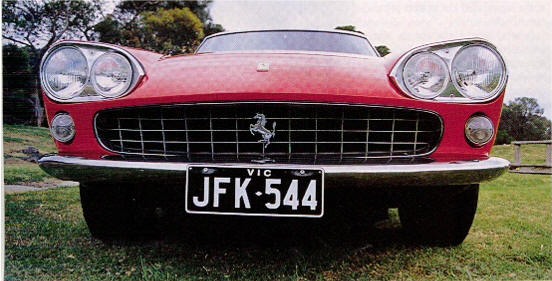
CONCLUSION
After driving this car, my hunch is proven correct. For a fairly modest price you get a Ferrari V12 engine, Pininfarina stying and performance to match. All of this adds up to great value. The 330 GT is an under-appreciated gem and will satisfy any driver who wants both Ferrari style and pace without having to mortgage the house.
Thank you to Paul Sabine and Anthony Joseph of Brooklands Motors of Sandringham for the loan of the car.
SPECIFICATIONS, DIMENSIONS & | |
| Year of Manufacture | 1965 |
| Production | 1080 (Approximately 625 cars with quad headlights) |
| Production dates | 1964 -1967 |
| Chassis | Elliptical section steel tubes |
| Body | Two-door, 2+2 seat coupe. Steel body styled by Pininfarina |
| Suspension | Independent, trapezoid wishbones, coil springs and anti-roll bar (front). Live axle with semi-elliptic leaf springs (rear) |
| Steering | Unassisted |
| Brakes | Dunlop discs all round |
| Wheels | Three-eared, knock-off 15-inch Borrani wires |
| Tyres | Pirelli P5 205/70 VR15 |
| Engine | 3967cc, alloy overhead cam V12. Two valves per cylinder, 8.8:1 compression ratio, Three Weber 40 DCZ/6 down draught carburettors, |
| Power | 300 bhp © 7,000 rpm |
| Transmission | Four-speed with Laycock overdrive |
| Length | 4,840mm |
| Width | 1,715mm |
| Height | 1,365mm |
| Weight | 1,420kg |
| Top speed | 245 km/h 0 - 100 km/h In 7.5 seconds |
| Price | Price $60,000 - $85,000 |
(The above are taken from contemporary road tests and reports) | |
Copyright 2004, Australian Classic Motoring Press Pty Ltd
AUSTRALIAN CLASSIC CAR FEBRUARY 2004 www.ccar.com.au
